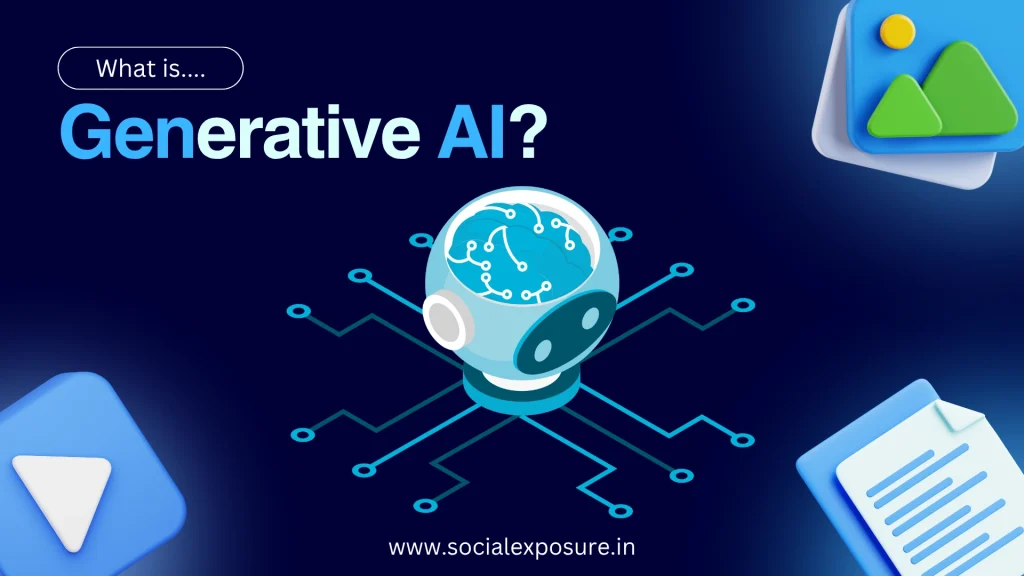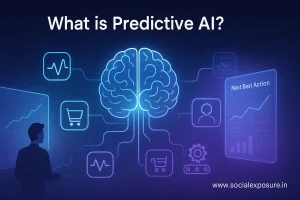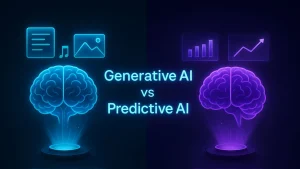A few years ago, artificial intelligence felt like a concept reserved for science labs and tech giants. Today, it’s everywhere. From personalized chat replies to AI-generated images, what was once experimental has become mainstream. But one particular branch is raising eyebrows and curiosity more than ever: generative AI.
You might have heard the term thrown around in headlines or product launches. Still, most people are asking the same question: what exactly is gen AI, and why is everyone talking about it now?
The rise of generative AI isn’t just catching headlines, it’s shifting how industries think about productivity and growth. According to McKinsey’s 2023 research on the economic potential of generative AI, the technology could contribute between $2.6 trillion to $4.4 trillion annually to the global economy. These gains are projected to come from transforming tasks across marketing, sales, software development, customer operations, and product R&D.
What’s more, McKinsey noted that about 75 percent of the value that generative AI could deliver would fall across just four business functions making it not only powerful but highly targeted in its impact.
But beyond numbers, there’s genuine user interest. Students want to learn how it works. Founders want to know if it can cut costs. Developers want to integrate it into apps. And business owners are wondering how to use it without making risky decisions.
That’s where this guide comes in.
By the end of this blog, you’ll have a clear understanding of what generative AI really means, how it functions under the hood, what it’s used for, and how to assess its role in your own field whether you’re building, learning, or planning.
Powered by Social Exposure, the Best Digital Marketing Agency.
What is Generative AI?
When most people hear the term generative AI, they picture chatbots, image generators, or tools that can mimic human conversation. But at its core, the idea is much simpler. Generative AI refers to a category of artificial intelligence that can create new content on its own. Not just repeat what it has seen, but produce original responses, visuals, music, or even code all based on the patterns it has learned from massive datasets.
Think of it like this. Traditional AI systems are good at making predictions. They sort spam emails, suggest products, or recognize faces by learning fixed rules from labeled data. But gen AI goes a step further. It’s trained not just to understand, but to generate. It creates machine-generated content that feels natural, timely, and in many cases, surprisingly relevant to the user’s input.
The reason so many industries are paying attention is that these models aren’t just spitting out random information. They’re trained on everything from books and articles to videos and source code. Large language models, like the ones behind modern AI tools, process billions of examples to learn how people speak, write, and express ideas.
This ability to respond with coherence and variety makes generative AI a powerful tool in customer support, content creation, education, product design, and even health research. Whether you’re writing an email or designing a product mockup, what is generative AI isn’t just a question of definition anymore it’s something that’s actively changing how we work, learn, and communicate.
How Does Generative AI Work?
To understand how generative AI works, imagine giving a student thousands of books, images, and videos to study. Over time, they’d learn how language flows, how images are structured, and how ideas connect. Now imagine asking that student to write a story, draw a picture, or summarize a video based only on what they’ve learned. That’s the essence of how generative models function.
These systems don’t memorize and repeat. They learn patterns, styles, and structures using machine learning models, especially neural networks, to create something entirely new each time.
Here’s how it generally works:
- Training: The AI is trained on large sets of data text, images, or videos so it can learn patterns, styles, and structure.
- Modeling: These patterns are used to build a generative model, like a large language model, which understands how to respond to prompts or generate content that fits a certain context.
- Generation: When you ask a question or give it a prompt, the model doesn’t pull an answer from a database. Instead, it uses probability and learned patterns to generate a response in real time.
- Refinement: In some cases, models go through fine-tuning or reinforcement, improving their accuracy and tone based on feedback or usage.
Let’s say you ask it to write a poem. The system will look at the input, check what it knows about poetic structure, and build something new that sounds human. The same happens when it generates product designs, business emails, or explainer videos.
The foundation of all this lies in the use of neural networks and the scale of data used to train them. The more diverse and high-quality the data, the more capable the system becomes in responding intelligently even creatively.
What Makes Generative AI Different from Traditional AI?
At first glance, gen AI and traditional AI might seem like parts of the same system. They both fall under the umbrella of artificial intelligence, but their purposes and results are quite different.
Traditional AI is built to recognize patterns and make decisions based on fixed rules. It’s great for sorting spam, calculating numbers, or recommending a movie based on your past behavior. It works within a known structure. Everything it does is based on what it’s been explicitly told.
Generative AI, on the other hand, is focused on creating new content. It doesn’t just process what it knows; it uses what it has learned to produce something new. That’s what makes it capable of writing blog posts, designing logos, or composing music that didn’t exist before.
Here’s a quick comparison to understand how generative AI differs from rule-based or traditional AI:
Feature | Traditional AI | Generative AI |
Core Function | Decision-making, classification | New content generation |
Learning Type | Rule-based, supervised | Pattern-based, unsupervised or semi-supervised |
Output | Predictive | Creative |
Common Use Cases | Fraud detection, recommendations | Image creation, writing assistance |
Data Handling Style | Fixed responses | Dynamic, open-ended responses |
Goal | Efficiency, accuracy | Creation, originality |
So, when we talk about gen AI vs traditional AI, the biggest contrast lies in intent. One is about solving known problems with known methods. The other is about building something fresh based on patterns, not pre-written rules.
What is the Main Goal of Generative AI?
If someone asks, what is the main goal of generative AI, the answer is surprisingly simple. Its purpose is to create new content that feels natural, useful, and original all without being explicitly programmed to do so.
Unlike traditional systems that analyze or sort existing data, generative AI is designed to take what it has learned and produce something entirely new from it. The goal is to enable machines to assist with tasks that require creativity, language fluency, and contextual understanding.
Here’s what that looks like in practice:
- Generate original text for blogs, emails, chat responses, or product descriptions
- Design visuals such as graphics, layouts, branding elements, or concept art
- Build code for websites, apps, or automation scripts based on simple instructions
- Create audio and video including voiceovers, music, or animations
- Summarize or personalize content for better user engagement and accessibility
All of these are real-world generative AI applications. They serve both individuals and organizations by removing routine creative bottlenecks and speeding up ideation.
In short, the main goal is to shift tasks that once required long hours of human effort into intelligent systems that can support or even accelerate those workflows. That’s what makes the uses of gen AI so valuable it doesn’t replace ideas, it helps bring them to life.
Where is Generative AI Used Today?
You’ve probably come across generative AI applications without even realizing it. From writing tools that help craft emails to product photos made by AI, the technology is already part of everyday tools people use across industries.
So, what is generative AI primarily used for today? It’s not just about experiments or tech demos. It’s helping businesses, creators, and even students do more with less time.
Here are some of the most common real-world uses:
- Content Generation: From blog writing to social media captions, content automation is now faster and more consistent with tools powered by generative AI.
- E-commerce: Brands use AI-generated visuals to create product mockups, banners, and ad creatives without needing large design teams.
- Customer Support: Many websites rely on AI-powered chatbots that handle queries using natural, human-like responses.
- SEO and Marketing: Tools that suggest keywords, optimize headlines, and write ad copy are common forms of AI in marketing.
- Education: Students and teachers use it to summarize lessons, explain concepts, and create learning materials.
- Entertainment: Music, voiceovers, and short videos are now being produced with just a prompt, often used in digital storytelling or ads.
- Recruitment and HR: Resume builders, job descriptions, and even performance feedback can now be generated with AI assistance.
Each of these examples shows that generative AI applications are not limited to tech labs. They’re already reshaping how people work, communicate, and grow their ideas across both small businesses and large enterprises.
Benefits and Limitations of Generative AI
Like any tool, generative AI comes with advantages that drive value, and limitations that users should be aware of. Whether you’re a business owner or someone just exploring the space, knowing the pros and cons of generative AI can help you make smarter decisions.
Benefits
- Faster content creation: Speeds up writing, design, and planning tasks across teams.
- Cost-saving: Reduces dependency on large creative teams or external vendors.
- Consistency: Maintains tone and style across different formats like blogs, ads, and email campaigns.
- 24/7 support: Powers chatbots that serve users outside of business hours.
- Personalization: Adjusts content to match different user preferences or platforms.
Limitations
- Lack of human judgment: AI doesn’t always understand nuance, emotion, or cultural sensitivity.
- Quality variation: Not every result is accurate or helpful. Edits and reviews are often needed.
- Originality issues: Output can sometimes be repetitive or too close to the data it was trained on.
- Data risk: Sensitive or confidential business input may not be safe in all AI tools.
- Dependence: Relying too much on automation can reduce creative thinking within teams.
These are important considerations, especially for businesses integrating AI into their processes. That’s why Social Exposure helps businesses adopt safe and effective AI strategies, balancing automation with human insight to stay ahead without risking brand value.
Misconceptions about Generative AI
As interest in generative AI grows, so do the myths. It’s easy to assume that AI systems are flawless or ready to replace humans. But many of these assumptions are far from reality. Clearing up common confusion helps people use the technology responsibly and with the right expectations.
Here are some of the most common myths about generative AI:
It’s always accurate
In truth, accuracy depends on the quality of training data and the prompt given. Generative models don’t think they predict likely outputs based on patterns. Mistakes, outdated facts, or completely made-up content can still happen. This is why AI accuracy must be reviewed by humans before use.
It replaces creative professionals
While it helps with scale and speed, AI lacks human judgment, emotional depth, and lived experience. Most tools are made to assist, not replace. Human direction still matters in brand voice, storytelling, and visual identity.
AI tools don’t need guidance
The output quality relies heavily on the input. Users who guide the system with clear, specific prompts have far better outcomes. That’s where user control over AI outputs plays a big role.
It’s always safe to use
Not all tools guarantee privacy or ethical use of data. Many businesses ask, is generative AI safe to use, and the answer depends on how it’s implemented. Always check the privacy policy and data practices of the platform you’re using.
Understanding the limits of these systems helps prevent misuse and ensures you’re getting the best out of them, whether you’re using AI for marketing, learning, or content creation.
Who Should Learn or Use Generative AI?
The interest in generative AI isn’t just limited to developers or tech firms. Its practical use has spread across industries, making it valuable for a wide range of people. Whether you’re planning to build tools, grow a business, or improve productivity, learning how to use or apply AI can be a smart move.
Here’s who can benefit the most and why:
- Students and lifelong learners: Those exploring a career in AI or modern tech fields can start with learning generative AI courses or workshops. Understanding prompt structure, output evaluation, and ethical use gives them an edge in both academics and job markets.
- Developers and software teams: Coding assistants, API integrations, and AI-generated documentation are speeding up development cycles. Developers who learn how to fine-tune or apply models can solve problems faster and automate more efficiently.
- Business owners and entrepreneurs: AI content tools help with customer support, marketing, lead generation, and product description writing. Many AI tools for business owners now require no coding, which opens up new ways to streamline everyday operations.
- Marketers and content creators: Email writing, SEO planning, social posts, and video scripts can all be powered by generative tools. Professionals who combine their creativity with AI’s scale get better results in less time.
- Agencies and startup teams: For small and growing digital brands, learning how to use AI responsibly means staying competitive without increasing overhead.
That’s why Social Exposure provides AI marketing guidance for startups and digital businesses, helping them not only adopt the right tools but also understand how to use them effectively and ethically.
Conclusion
In just a short time, generative AI has moved from experimental labs to everyday tools. It’s not only helping people write, design, and communicate faster, it’s also changing how we approach learning, creativity, and automation. Whether you’re a student exploring possibilities, a business owner looking to simplify tasks, or a team aiming to do more with fewer resources, the value is real as long as the technology is used thoughtfully.
As the tools grow more advanced, understanding how they work and where they fit becomes just as important as using them. It’s not about replacing humans, but about helping people focus on what they do best, while machines handle the repetitive layers of creation.
Generative AI is shaping how we build, solve, and interact and the opportunity to use it wisely is in your hands. Social Exposure helps you stay ahead with the right AI-driven approach.
Frequently Asked Questions
What is generative AI in simple words?
Generative AI refers to a type of artificial intelligence that can create new content like text, images, or audio based on what it has learned. It doesn’t copy or repeat, but instead produces fresh results using patterns it understands from data.
How is generative AI different from traditional AI?
The key difference lies in the output. Traditional AI systems focus on recognizing patterns or making predictions, while generative AI is built to create content, such as articles, visuals, or summaries. This makes it ideal for tasks where creativity or originality is involved.
What can generative AI create?
It can produce a wide range of content, including blog posts, product images, email replies, voiceovers, and even video clips. AI-generated visuals and automated text are commonly used in marketing, e-commerce, and education.
Is generative AI only used for content?
No, it’s also used for writing code, generating business reports, building chat experiences, and more. While content automation is one of its strengths, the technology goes far beyond just writing or designing.
Who uses generative AI today?
Businesses, developers, educators, marketers, and content creators are all using it. Generative AI applications are now common in industries like healthcare, e-commerce, finance, and entertainment. Powered by insights from Social Exposure, even small startups are using it to speed up creative workflows.
Can students or beginners learn generative AI?
Yes, many platforms now offer beginner-friendly courses to help people learn generative AI without needing a background in programming. Students exploring a career in AI can start by learning how to prompt, test, and evaluate results.
What tools use generative AI?
Popular tools include ChatGPT, Jasper, Canva’s AI features, GitHub Copilot, and various AI-powered design and writing assistants. These tools use machine learning models to provide outputs based on user input.
Is generative AI safe and reliable?
In most use cases, yes, but with caution. Questions like is generative AI safe and reliable depend on the tool’s data practices and how it’s used. Always review outputs before publishing and avoid inputting sensitive or private information.
What industries are using generative AI?
Industries like retail, media, advertising, education, and healthcare are already benefiting from AI in marketing, training, and customer interaction. The applications keep growing as businesses find more ways to integrate it.
Will generative AI replace human jobs?
Not entirely. While it can handle repetitive or template-based tasks, most roles still require human oversight, creativity, and empathy. In many cases, it enhances productivity rather than replaces jobs. Social Exposure helps businesses adopt AI tools that support teams without removing the need for human insight.






